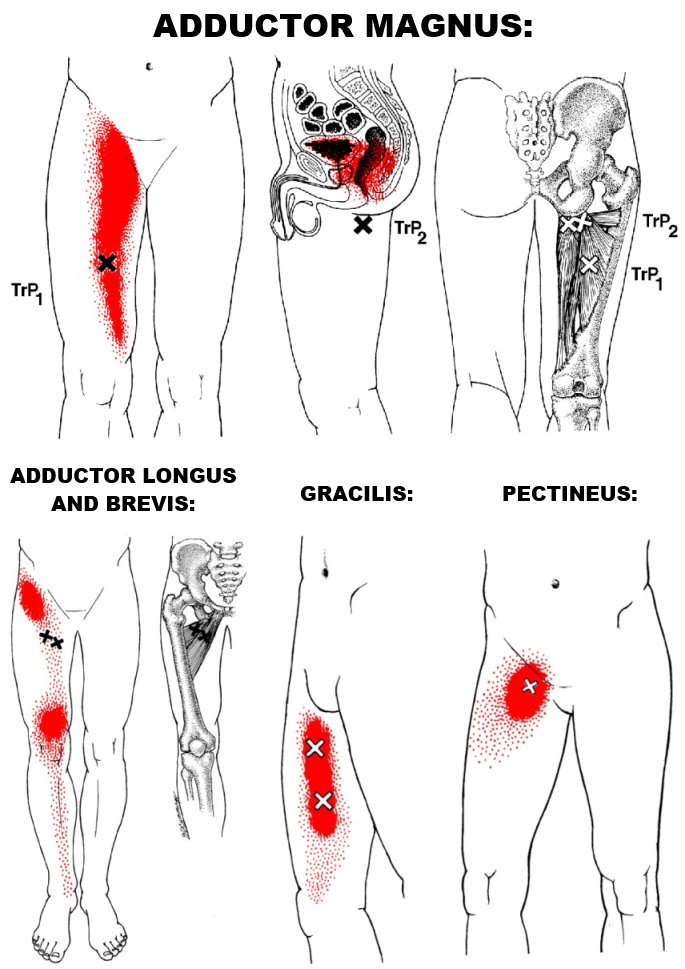Foam Rolling Friday: The Inner Thigh
In the medical world, the inner thigh is referred to as the adductor muscles. This group of muscles “add”uct or bring the legs back toward the midline of the body. When it comes to lower body dysfunctions and pain, this group of muscles can reign king in stirring up problems.
The Functional Anatomy
There are four muscles that utilize the anatomical name “adductor,” however, there are seven muscles that collectively function as adductors while standing. Now stating this, FUNCTIONALLY they do way more than add the leg back into the midline; depending on where the leg is in space, different adductor muscles will do different things.
The adductor muscles attach on the pelvis around the pubic bone. From here, they branch out and attach along the posterior and inside aspect of the femur (upper leg bone), from the hip to the knee. Some of these muscles cross the knee, while others do not. Throughout the process of walking, running, jumping, or lifting, these muscles have different effects directly and indirectly on the knee and pelvis.
In regard to foam rolling, the amount of knee bend and hip flexion will dictate what you will feel while foam rolling these muscles It is the same when it comes to the functionality of these muscles. Positioning of the knee (bent, straight, behind the body, or in front of the body) along with the degree of hip flexion, will dictate how these muscles fire collectively. This is important when it comes to athletic events. If there is tension in these muscles, they do not fire in unison properly resulting in potential injury and lack of performance.
Often when there is a lack of stabilization, this muscle group will over-activate. Overtime this over-activation strategy creates trigger points resulting in pain. The adductors are a last ditch effort to help stabilize the low back, pelvis, and lower extremity. You will often see tight adductors with lower cross syndrome, seen as overarching of the low back while standing. One specific muscle involved is the gracilis; it attaches to the pubic bone and medial condyle of the femur. When looking at the body from the side, this muscle attaches to the pubic bone in front of the attachment to the knee. If tight, this muscle will shorten, pulling at these two attachments. As a result, the lower back will start to overarch due to the angle of the pull from the pubic bone to the knee. A great functional test to help identify if overactive or tight adductor muscles are a limiting factor in your movement quality is the 6 inch step down, as seen in the video. The 6 inch step down is a fantastic test to identify limited movement quality through the hips and ankles.

The Why
The referral pattern for pain of these muscles are shown above. The black and white "Xs" indicate the location of a trigger point in the distinguished muscle and the red areas indicate where syptoms are commonly felt due to the activation of the trigger point. As you can see, the area of pain does not have to be local to where the pain generator is present. If you experience pain anywhere along these areas, you should try foam rolling these muscles where you see the appropriate X! It can be a very simple way in helping you eliminate pain, but also improving the function and performance of these muscles. If you participate in any athletic event, boot camp, or high intensity workouts, then you need to give these tips a shot! No excuses, just do it.
About the author
Dr. Keith Sparks is an award-winning chiropractor, functional medicine expert, and the co-founder of ICT Muscle & Joint Clinic. Dr. Sparks’ emphasis of care originated within the fields of rehabilitation, soft-tissue therapies, and chiropractic. To date, he has brought this unique combination of skills into union with functional medicine. The sole purpose of intertwining these distinct skills, knowledge, and services is to provide incomparable care to his local community. Dr. Keith Sparks is often seen in the Wichita, KS community speaking at business events and teaching health and performance classes.
